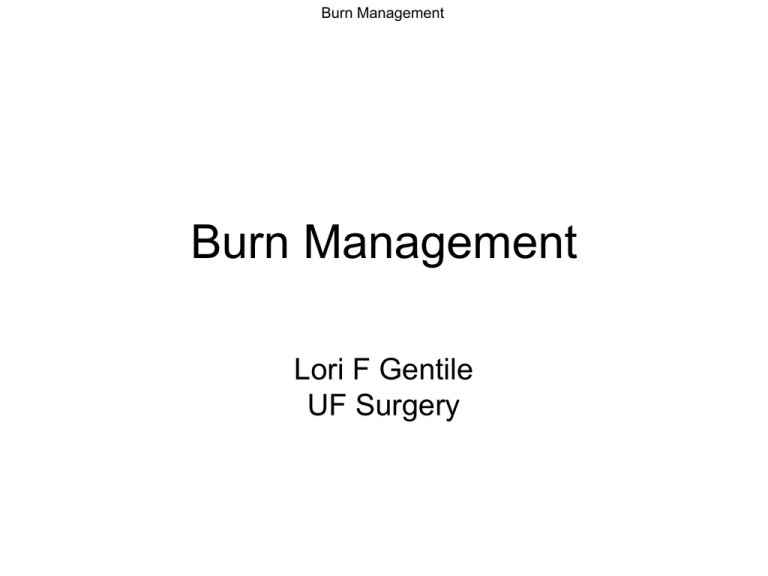
Burn Management
Burn Management
Lori F Gentile
UF Surgery
Burn Management
Burn Management
Burn Classification
Superficial (1°): epidermis (sunburn)
Partial-thickness (2°):
Superficial partial-thickness: papillary dermis
Blisters with fluid collection at the interface of the
epidermis and dermis. Tissue pink & wet. Hair
follicles intact
Deep partial-thickness: reticular dermis
Blisters. Tissue molted, dry, decreased sensation.
Full-thickness (3°): dermis
Leathery, firm, insensate.
4th degree: skin, subcutaneous fat, muscle, bone
Burn Management
Classification of Burn Depth
Burn Management
Types of Burns
• Heat/flame/contact- scald burns most common
• Electrical – look for entry and exit wound
– Cardiac monitoring, watch for rhabdo/cmpt synd
• Acid/alkali – irrigate with water
• Hydrofluoric acid – topical calcium powder
• Powder – wipe away, then irrigate
Burn Management
Initial Assessment
•
•
•
•
•
Airway
Breathing
Circulation
Disability
Exposure
• Initial burn treatment: remove burn source
Burn Management
Assessment: Airway
• Airway at risk secondary to:
– Direct injury/trauma
– Fluid resuscitation
– Edema from inflammatory response
• Clues to airway injury: history (closed
spaces), facial burn, carbonaceous
sputum, hoarseness, stridor, wheezing
• Intubate based on respiratory and mental
status
Burn Management
Inhalation Injury
• Carbon monoxide poisoning – tx 100%
O2
• Upper airway thermal injury
• Lower airway burn injury
• Evaluate with bronchoscopy if uncertain
Burn Management
The Rule of Nines and Lund–Browder Charts
Orgill D. N Engl J Med 2009;360:893-901
Burn Management
Burn Pathophysiology
• Severe inflammatory reaction
– Capillary leak
– Intravascular fluid loss
– High fevers
– Organ Malperfusion
– MSOF
Burn Management
Fluid Resuscitation
• Resuscitation based on burn size (2nd &
3rd degree only)
– LR in 1st 24 hrs
• Parkland formula (burn >20% TBSA)
– 4 x Wt(kg) x %TBSA = mL/24 hours
– Deliver 1/2 volume over 1st 8hrs
– Deliver 2nd half over next 16 hours
• Other formulas exist
• Titrate to urine output
Burn Management
Escharotomy Indications
• Circumferential burns
• Cool extremity, weak pulse, decreased
capillary refill, decreased pain
• Difficulty with ventilation in chest burns
Burn Management
Wound Management: General
• Clean & debride wound
• Prophylactic IV abx unnecessary
• Topical abx delay wound colonization
and infection
– >105 for a wound infection-need
quantitative counts
• Excise burns in < 72 hrs
Burn Management
Wound Management: Topical
Antibiotics
• Mafenide acetate (Sulfamylon) for cartilage
– Good at penetrating eschar but is painful
– Broad spectrum
– Side effect: metabolic acidosis via carbonic
anhydrase inhibition
• Bacitracin for face
– Gram-positive bacteria
• Silver sulfadiazine (Silvadene) for trunk &
extremities
–
–
–
–
Broad spectrum
Does not penetrate eschar very well
Avoid if sulfa allergy
Side effects: neutropenia/thrombocytopenia
Burn Management
Wound Management: Burn Excision
& Grafting
• Autograft
• Full-thickness skin grafts (FTSG)
• Split-thickness skin grafts (STSG) – epidermin/pt dermis,
more likely to survive
• Meshed vs. Sheet
• Allograft- temporary, replaced aft 2 weeks
• Porcine xenograft – Deep partial thickness
• Dermal substitutes: Integra, expensive
Burn Management
Electrical Burns
• Categories: high voltage (>1000 volts), low
voltage, lightning
• High voltage: requires trauma evaluation
– Local injury, deep injury, fractures, blunt
injuries
– Risk of rhabdomyolysis, compartment
syndrome, cardiac injury
• Low voltage: common in children
– Local injury
• Late complications: cataracts, progressive
demyelinating neurologic loss
Burn Management
Chemical Burns
•
•
•
•
•
Empirical treatment
End the exposure
ABCDE
Alkalis generally cause worse damage
Initial treatment for acid or alkali: irrigation
with water
• Dry powder should be brushed off
• Hydrofluoric acid: can cause severe
hypoCa
Burn Management
Take Home
•
•
•
•
•
•
Always start with ABCDE for trauma/burns
The airway is at risk in burn patients
Parkland formula for initial resuscitation
Rule of Nines
Keep burns clean with soap & topical abx
Early burn excision & grafting saves lives








